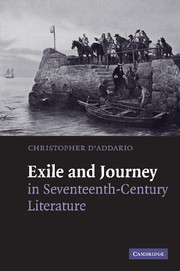Book contents
- Frontmatter
- Contents
- Acknowledgments
- Introduction: The “remanence” of the past: the early modern text in exile
- 1 Nostalgia and nationalism in New England literature
- 2 Exile and the semantic education of Thomas Hobbes's Leviathan
- 3 The expulsion from Paradise: Milton, epic and the restoration exiles
- 4 Sybil's leaves: Dryden and the historiography of exile
- Epilogue
- Notes
- Index
Introduction: The “remanence” of the past: the early modern text in exile
Published online by Cambridge University Press: 22 September 2009
- Frontmatter
- Contents
- Acknowledgments
- Introduction: The “remanence” of the past: the early modern text in exile
- 1 Nostalgia and nationalism in New England literature
- 2 Exile and the semantic education of Thomas Hobbes's Leviathan
- 3 The expulsion from Paradise: Milton, epic and the restoration exiles
- 4 Sybil's leaves: Dryden and the historiography of exile
- Epilogue
- Notes
- Index
Summary
After a lifetime of wars and conflicts the sixteenth-century Italian writer Matteo Bandello reflected on the disturbances of his native land from exile in Agen, France. Bandello, monk, diplomat, soldier and author, ruminated that, with all of the displaced Italians now living far from their patria, an entire city of exiles could be founded and populated. However, the aging monk does not dwell long on this imagined city, rather letting it fade from the page and from memory. The ephemeral appearance of this city is typical of the imagined geographies of exile, geographies that emerge more often as figments of space and time rather than as realistic, concrete memories. This is not to say that memories do not drive the exile's imaginings; indeed, it is the rupture of departure, and the lingering shadow of the homeland left behind, that gives rise to Bandello's imagined city. Yet Bandello, who left Florence when the Spanish invaded in 1522, does not envision or reconstruct his lost patria in the text, but rather imagines a city characterized primarily by the collective experience of exile, its inhabitants not reminiscing about the lost quotidian particulars of Florentine life, but rather about their various stories of displacement. Almost five hundred years later, Russian exiles in New York City would similarly recreate stories about their exiles as they collected “diasporic souvenirs” that displayed their wanderings while admitting a multiple, transient belonging that lay somewhere between New York City and St. Petersburg.
- Type
- Chapter
- Information
- Exile and Journey in Seventeenth-Century Literature , pp. 1 - 21Publisher: Cambridge University PressPrint publication year: 2007



